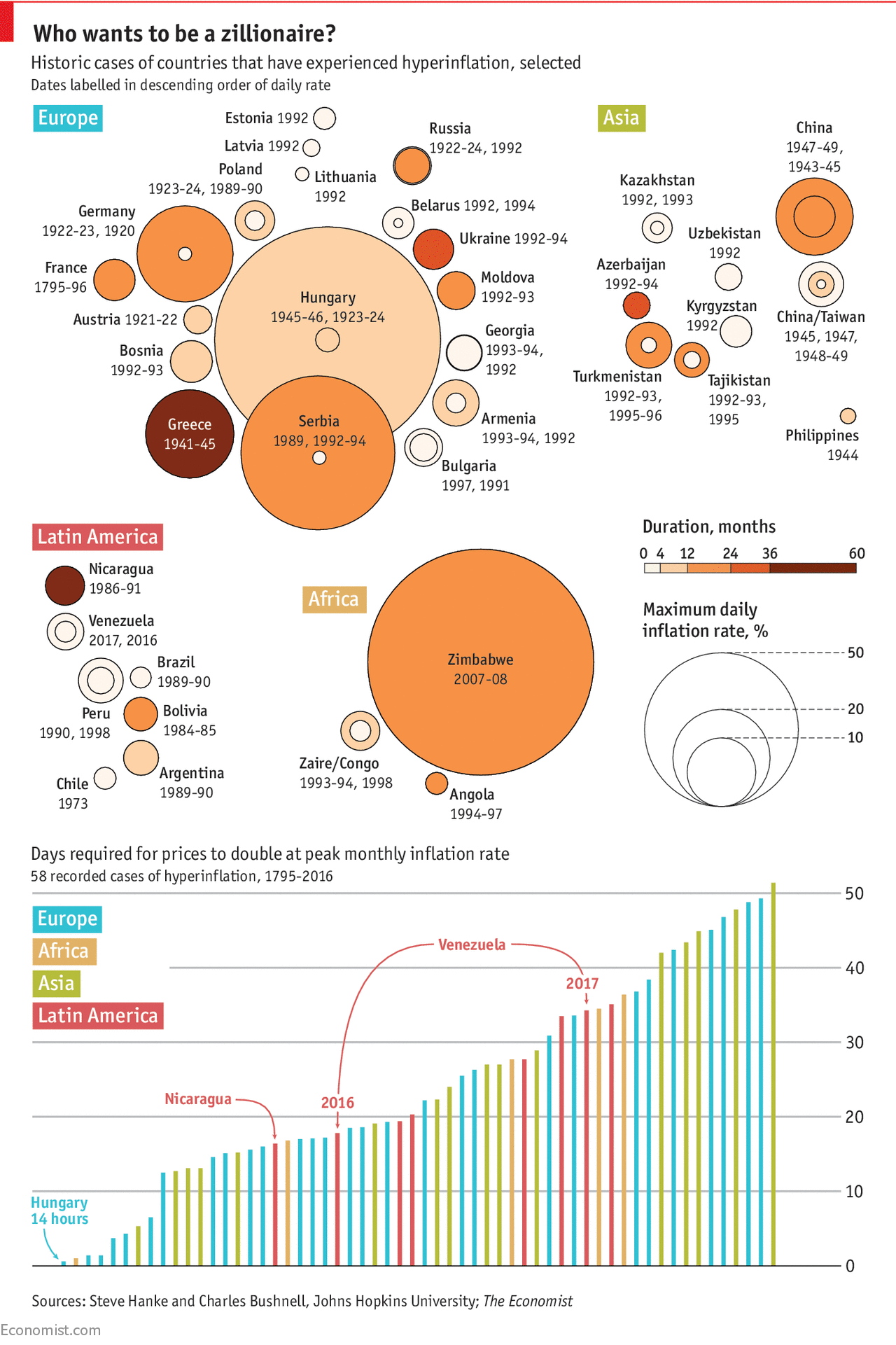When the prices are too damn high
Inflation in Venezuela is starting to rival some of history’s most notorious economic debacles

By THE DATA TEAM
MUCH ink has been spilt in recent years on news articles about Venezuela’s increasingly dire economic situation. Perhaps even more ink has been needed to sate the country’s ever-growing appetite for freshly printed banknotes. While the Venezuelan economy has contracted for four consecutive years, inflation has taken off: last month the opposition-led National Assembly announced that consumer prices increased by 2,616% in 2017, and in December alone rose 85%. The government stopped releasing official statistics on consumer prices in 2016, but anecdotal news reports and the black-market exchange rate for the country’s currency lend credence to the opposition’s claims.
Many economists and central bankers would qualify December’s price rise as “hyperinflation”, usually defined as a rise in consumer prices of at least 50% over a month. That implies an annualised rate of 12,875%, with prices doubling every 52 days. Steve Hanke, an economist at Johns Hopkins University, has (with colleagues) used this definition to compile a list of 57 recorded cases of hyperinflation from 1795 to 2016. If the IMF’s latest forecast for inflation of “about 13,000%” in 2018 proves accurate, Venezuela’s latest bout—its second in a year—would add a 58th (see chart).
Low oil prices, declining oil production and general economic mismanagement have left the Venezuelan government struggling to pay its bills, driving the budget deficit to nearly 20% of GDP. In reaction it has printed bolívares with abandon: the monetary base has expanded by more than 4,000% in two years, and last year the largest-denomination banknote was increased to 100,000 bolívares. (In an attempt to create something of more lasting value, on February 20th Venezuela will even launch a crypto-currency, the “petro”, backed by oil and other reserves.) Meanwhile, on the black market, the bolívar has declined by 99.6% against the dollar since the start of 2016, leaving the biggest note’s value at less than 50 American cents (though an announcement last week that the government would partly liberalise some official exchange rates has boosted the unofficial rate by about 20%). While this torrent of new cash has flooded the economy, domestic production of goods has collapsed and the cost of imports in local currency has soared—a combination that has made it virtually impossible for consumers to keep up with rising prices.
Fortunately, of the known episodes of hyperinflation around the world, over half ended within a year, and only a tenth of those lasted more than six months. (The longest case, in Nicaragua, saw such extreme price increases sustained for nearly five years, from 1986 to 1991.) Hyperinflation can make daily living so harsh and business so inconvenient that it is usually not tolerated for long—often leading to a change in government, or at least to new economic policies needed to restore monetary order. However, Nicolás Maduro, the country’s autocratic president, has proven himself willing to squelch street protests by force, and has already remained in office far longer than many observers thought possible. Moreover, the one price Mr Maduro wants to see go up—that of crude oil—has moved in his favour of late. The more money Venezuela receives for its black gold, the less it will need to produce at the printing press.
Correction (February 6th 2018): We originally stated that Venezuela's biggest banknote was 20,000 bolívares. Actually the largest denomination is already 100,000 bolívares. Keeping up with the printing presses can be daunting. Sorry.
Discover more

Which way will swing voters lean in America’s election?
Our build-a-voter model shows where Kamala Harris and Donald Trump look particularly vulnerable

Our guide to how Trump or Harris might win the election
Keep these two charts handy as the votes come in

The best, and worst, places to live in the Americas
Why Canada has the edge over its southern neighbours
Our footloose index: the most attractive countries for graduates
Southern Europe has become increasingly appealing for mobile talent
An alternative use for The Economist’s Big Mac index
Which countries have the highest purchasing power?
The war in Sudan, in maps and charts
Satellite images reveal the pace at which mass burial sites are growing